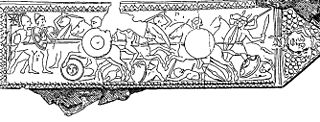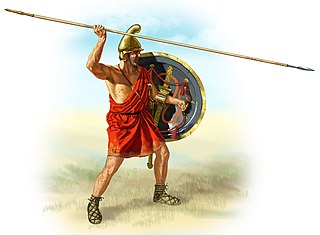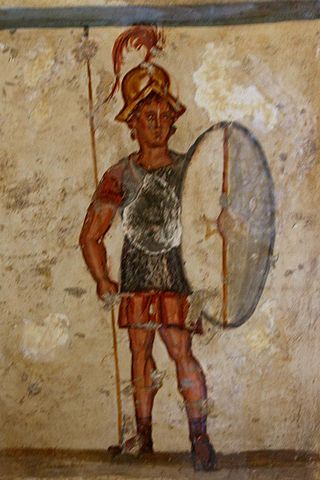Related Research Articles

The Seleucid Empire was a Greek power in West Asia during the Hellenistic period. It was founded in 312 BC by the Macedonian general Seleucus I Nicator, following the division of the Macedonian Empire founded by Alexander the Great, and ruled by the Seleucid dynasty until its annexation by the Roman Republic under Pompey in 63 BC.

The Battle of Magnesia took place in either December 190 or January 189 BC. It was fought as part of the Roman–Seleucid War, pitting forces of the Roman Republic led by the consul Lucius Cornelius Scipio Asiaticus and the allied Kingdom of Pergamon under Eumenes II against a Seleucid army of Antiochus III the Great. The two armies initially camped northeast of Magnesia ad Sipylum in Asia Minor, attempting to provoke each other into a battle on favorable terrain for several days.

The Battle of Raphia, was fought on 22 June 217 BC near modern Rafah between the forces of Ptolemy IV Philopator, Greek king and pharaoh of Ptolemaic Egypt and Antiochus III the Great of the Greek Seleucid Empire during the Syrian Wars of the Greeks. It was one of the largest battles of the Hellenistic kingdoms and of the ancient world, and determined the sovereignty of Coele Syria.

The Battle of Beth Zechariah took place around May 162 BC during the Maccabean revolt fought between Jewish rebels under the leadership of Judas Maccabeus against an army of the Seleucid Empire, the Greek successor state (diadochi) to the Macedonian conquests that controlled Syria and Babylonia. The battle was fought at Beth Zechariah and was a Seleucid victory, with the rebels driven from the field in retreat. Judas's brother Eleazar Avaran died in combat with a war elephant. The defeat allowed the Seleucids to continue their campaign and besiege the Jewish holy city of Jerusalem.

The sarissa or sarisa was a long spear or pike about 5 to 7 meters in length. It was introduced by Philip II of Macedon and was used in his Macedonian phalanxes as a replacement for the earlier dory, which was considerably shorter. These longer spears improved the strength of the phalanx by extending the rows of overlapping weapons projecting towards the enemy. After the conquests of Alexander the Great, the sarissa was a mainstay during the Hellenistic era by the Hellenistic armies of the diadochi Greek successor states of Alexander's empire, as well as some of their rivals.

A hypaspist is a squire, man at arms, or "shield carrier". In Homer, Deiphobos advances "ὑπασπίδια" or under cover of his shield. By the time of Herodotus (426 BC), the word had come to mean a high status soldier as is strongly suggested by Herodotus in one of the earliest known uses:
Now the horse which Artybius rode was trained to fight with infantrymen by rearing up. Hearing this, Onesilus said to his hypaspist, a Carian of great renown in war and a valiant man ...

The army of the Kingdom of Macedon was among the greatest military forces of the ancient world. It was created and made formidable by King Philip II of Macedon; previously the army of Macedon had been of little account in the politics of the Greek world, and Macedonia had been regarded as a second-rate power.
Agema, plural agemata (αγήματα) is a term to describe a military detachment, used for a special purpose, such as guarding high valued targets. Due to its nature the agema most probably comprises elite troops.
The Argyraspides were elite Macedonian soldiers who carried silver-plated shields, hence their name. The original unit were hypaspists serving in the army of Alexander the Great. During the Wars of the Diadochi, they initially served Eumenes, but betrayed him to Antigonus I Monophthalmus at the Battle of Gabiene in 316. After their dispersal under Antigonus, later units of the Seleucid Empire and Roman Empire would be modeled after them.

The Battle of Thermopylae took place on 24 April 191 BC. It was fought as part of the Roman–Seleucid War, pitting forces of the Roman Republic led by the consul Manius Acilius Glabrio against a Seleucid-Aetolian army of Antiochus III the Great.

The Battle of Panium was fought in 200 BC near Paneas between Seleucid and Ptolemaic forces as part of the Fifth Syrian War. The Seleucids were led by Antiochus III the Great, while the Ptolemaic army was led by Scopas of Aetolia. The Seleucids achieved a complete victory, annihilating the Ptolemaic army and conquering the province of Coele-Syria. The Ptolemaic Kingdom never recovered from its defeat at Panium and ceased to be an independent great power. Antiochus secured his southern flank and began to concentrate on the looming conflict with the Roman Republic.

The thorakitai were a type of soldier in Hellenistic armies similar to the thureophoroi. The literal translation of the term is "cuirassiers", which suggests that they may have worn a short Celtic mail shirt or possibly a linothorax.
The military of Carthage was one of the largest military forces in the ancient world. Although Carthage's navy was always its main military force, the army acquired a key role in the spread of Carthaginian power over the native peoples of northern Africa and southern Iberian Peninsula from the 6th century BC and the 3rd century BC. Carthage's military also allowed it to expand into Sardinia and the Balearic Islands. This expansion transformed the military from a body of citizen-soldiers into a multinational force composed of a combination of allies, citizens and foreign mercenary units.
The Hellenistic armies is a term which refers to the various armies of the successor kingdoms to the Hellenistic period, emerging soon after the death of Alexander the Great in 323 BCE, when the Macedonian empire was split between his successors, known as the Diadochi.

The Roman–Seleucid war (192–188 BC), also called the Aetolian war, Antiochene war, Syrian war, and Syrian-Aetolian war was a military conflict between two coalitions, one led by the Roman Republic and the other led by the Seleucid king Antiochus III. The fighting took place in modern-day southern Greece, the Aegean Sea, and Asia Minor.
The Leukaspides were a group in the Antigonid Macedonian army. Scholars suggest two main possibilities for what precisely they were. The first is that they were equipped in the style of the Macedonian phalanx and were a counterpart to the Chalkaspides, a group uncontroversially known to be sarissa-wielding hoplites with bronze shields. In this possibility, they were probably only mustered when the Macedonians needed more manpower as a supplemental corps. The second possibility is that the Leukaspides referred to ethnically non-Macedonian troops hired as auxiliaries or mercenaries who fought using thyreos shields, which were wooden, oval-shaped, and covered with hide or felt. Ancient sources refer to a "phalanx" of Leukaspides several times, but in the second possibility, it is assumed that the word "phalanx" is meant in the broad sense of any organized military troop, rather than the specific sense of Greek-style spear phalanxes. Auxiliaries probably fought using whatever their locally trained weaponry was—swords, slings, battle axes, and so on.
Chalkaspides is a poetic term used by writers of Koine Greek to refer to a Macedonian phalanx. The most notable group called chalkaspides was the main phalanx force of the Antigonid Macedonian army in the Hellenistic period. The group were hoplites who fought in phalanx formation using long sarissas and bronze shields, either a pelta or an aspis. They may have been supplemented by another Antigonid force called the Leukaspides when more manpower was necessary, although the leukaspides are less well-attested to in ancient sources. The leukaspides may have been very similar to the chalkaspides and also fought as a phalanx, or they might be a term for non-Macedonian allies and mercenaries who used wooden thyreos shields rather than the bronze pelta.

The Antigonid Macedonian army was the army that evolved from the ancient Greek kingdom of Macedonia in the period when it was ruled by the Antigonid dynasty from 276 BC to 168 BC. It was seen as one of the principal Hellenistic fighting forces until its ultimate defeat at Roman hands at the Battle of Pydna in 168 BC. However, there was a brief resurgence in 150-148 during the revolt of Andriscus, a supposed heir to Perseus.

The Ptolemaic army was the army of the Ptolemaic Greek kings that ruled Egypt from 305 to 30 BC. Like most of the other armies of the Diadochi, it was very much Macedonian in style, with the use of the long pike (sarissa) in a deep phalanx formation. Despite the strength of the Ptolemaic army, evinced in 217 BC with the victory over the Seleucids at the Battle of Raphia, the Ptolemaic Kingdom itself fell into decline and by the time of Julius Caesar, it was but a mere client-kingdom of the Roman Republic. The army by the time of Caesar’s campaigns in the eastern Mediterranean was a mere shadow of its former self: generally, a highly disorganized assemblage of mercenaries and other foreign troops.
The military tactics of Alexander the Great have been widely regarded as evidence that he was one of the greatest generals in history. During the Battle of Chaeronea, won against the Athenian and Theban armies, and the battles of Granicius and of Issus, won against the Achaemenid Persian army of Darius III, Alexander employed the so-called "hammer and anvil" tactic. However, in the Battle of Gaugamela, the Persians possessed an army vastly superior in numbers to the Macedonian army. This tactic of encirclement by rapid shock units was not very feasible. Alexander had to compose and decide on an innovative combat formation for the time; he arranged his units in levels; he pretended to want to encircle the enemy in order to better divide it and thus opened a breach in its defensive lines.
References
- ↑ Head, 1982, p.20
- ↑ Chaniotis, 2006, p.86
- 1 2 3 4 Head, 1982, p.23
- ↑ Chaniotis, 2006, p.85
- ↑ Bar-Kochva 1989, p. 30–36
- ↑ Bar-Kochva, 1989, p.191
- ↑ Griffith, 1935, p.153
- ↑ Bar-Kochva,1979, p.59-62
- ↑ Sekunda, 2001, p.89
- ↑ Polybius 5.79.4
- ↑ Cambridge Ancient History: Volume VII, 1984, p.190
- ↑ Polybius 30.25.3
- ↑ Tarn, 1980, p.184
- 1 2 Sekunda, 2001, p.98-100
- ↑ Beston, 2002, p.388-389
- ↑ Sekunda, 2001, p.91. See also 1 Maccabees 6:39.
- 1 2 3 Head, 1982, p.24
- ↑ Bevan, 1902, p.224
- ↑ I Macc.II.38
- ↑ Josephus Ant.XIII.129
- ↑ Josephus Ant.XIII.144
- 1 2 Head, 1982, p.25
- ↑ Bar-Kochva, 1979, p.142-45
- ↑ Appian Syr.37
- ↑ Bar-Kochva, 1989, p.16
- ↑ Gaebel, 2002, p.242
- ↑ Polybius 10.49
- ↑ Gaebel, 2002, p.293
- ↑ Plut.Flam.17.5
- 1 2 3 4 5 6 Livy XXXVII.40
- 1 2 3 "Appian, The Syrian Wars 7 - Livius". www.livius.org.
- ↑ Bar-Kochva, 1979,p.68
- ↑ Head, 1982, p.118
- 1 2 3 Sekunda, 1994, p.24
- 1 2 Bar-Kochva, 1989, p.13
- ↑ Polybius 16.18
- ↑ Appian, Syriaca 7
- ↑ Xenophon, Cyropaedia, Ζ.1.27
- ↑ Sherwin-White & Kuhrt, 1993, p.222